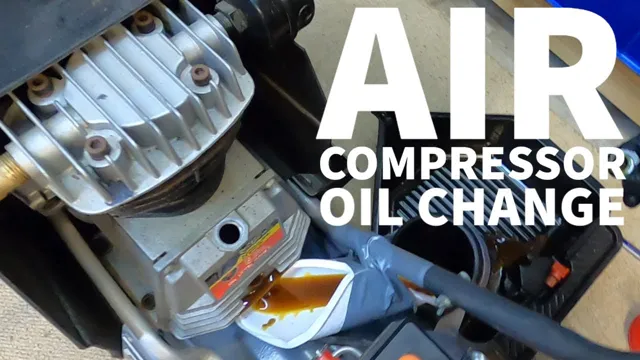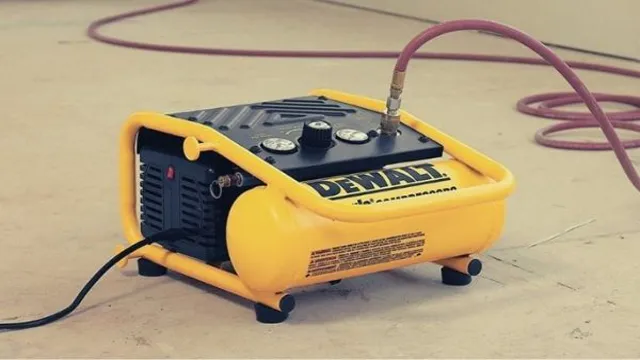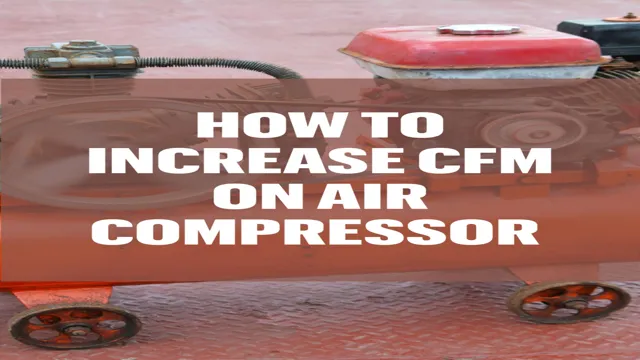
Have you ever wondered what goes on inside a reciprocating air compressor? Whether you are a DIY enthusiast or a professional mechanic, knowing how to disassemble and assemble a reciprocating air compressor can save you money and time. This essential skill can come in handy when you need to replace worn-out parts or troubleshoot a malfunctioning compressor. Disassembling and assembling a reciprocating air compressor might sound intimidating, but with the right tools and technique, it can be a straightforward process.
It involves breaking down the different components of the compressor, inspecting each part, cleaning or replacing as needed, and putting everything back together. Before you get started, ensure that you have a detailed guide, the necessary tools, and protective gear. Some of the critical components you will need to check include the piston, connecting rod, crankshaft, valves, and air filter.
Understanding the different parts of the reciprocatory air compressor is crucial in assembling it correctly. Also, while disassembling, not taking note of proper assembly procedures can lead to costly mistakes such as breaking small parts. Hence, it is crucial to pay attention to details during the whole process.
With this guide and your hands-on skills, you can confidently disassemble and assemble your reciprocating air compressor in no time. This knowledge comes in handy when the compressor breaks down and needs repairs.
Introduction
If you own a reciprocating air compressor, one important skill you should have is knowing how to disassemble and assemble it. This way, you can perform regular maintenance and repairs on your compressor without having to rely on a professional. Before you begin, make sure that you have all the necessary tools and equipment, including safety goggles, gloves, and a wrench.
Start by removing the belt guard and air filter, followed by the belt, pulley, cylinder head, and valve plate. Clean and inspect each individual part thoroughly before reassembling the compressor. Keep in mind that the disassembly and assembly process may vary depending on the make and model of your reciprocating air compressor, so refer to the manufacturer’s manual for specific instructions.
By performing regular maintenance, you can ensure that your compressor runs smoothly and efficiently, prolonging its lifespan and reducing the risk of costly repairs.
Explanation of Reciprocating Air Compressors
Reciprocating air compressors are widely used in various industries and applications. These compressors work by converting power into potential energy, which is stored compressed air. The compressed air is then stored in a tank and utilized for various applications such as powering pneumatic tools, filling tires, and even operating machinery.
Reciprocating air compressors have components such as cylinders, pistons, valves, and a crankshafts that work together to compress air. This type of compressor is very versatile and can produce a high amount of pressure, making them great for heavy-duty work like auto-repair, construction, and manufacturing. If you are in need of an air compressor that is reliable, efficient, and able to handle high-pressure applications, reciprocating air compressors are an excellent option to consider.

Importance of Disassembling and Assembling Air Compressors
Air compressors are essential machines in various industries, and whether you’re using them for commercial purposes or at home, it’s important to know how to disassemble and assemble them. Disassembling an air compressor allows you to clean and maintain its individual components, while assembling it ensures that it operates efficiently and safely. Neglecting to properly maintain an air compressor can lead to costly repairs and even accidents.
By disassembling and assembling your air compressor, you can prolong its lifespan and ensure that it functions optimally. So, whether you’re a professional mechanic or a DIY enthusiast, it’s important to familiarize yourself with the inner workings of your air compressor.
Disassembly Process
If you ever need to perform maintenance or repair on your reciprocating air compressor, it is important to know how to disassemble and assemble it properly. To begin the disassembly process, turn off the power supply and disconnect any hoses or wires from the unit. Then, remove the belts and pulleys from the motor shaft.
Next, remove any remaining screws or fasteners holding the compressor together, and carefully lift the top and bottom halves apart. Once the unit is disassembled, you can inspect and clean each component, and replace any worn or damaged parts. To assemble the compressor, simply reverse the steps taken during disassembly.
Start by placing the lower half of the unit back on a level surface, then carefully align the upper half, and secure it together with the screws or fasteners. After that, reattach the belts and pulleys, and reconnect the hoses and wires. Remember to fully tighten everything, and test the compressor before using it.
By following these steps, you can ensure a smooth disassembly and assembly process for your reciprocating air compressor.
Gather the Necessary Tools
When it comes to disassembling anything, one of the first things you need to consider is having the right tools for the job. Whether it’s a piece of machinery or an electronic device, you need to ensure you have all the necessary tools to take it apart safely and efficiently without damaging it. Some of the most common tools you’ll need for disassembly include screwdrivers, pliers, wire cutters, and a variety of other specialized tools depending on the complexity of the device itself.
Without the proper tools, you risk injuring yourself or causing damage to the device you’re working on. So, take the time to gather all the tools you need before getting started, and make sure they’re in good working condition so you can tackle the disassembly process with ease and confidence.
Preparing the Air Compressor for Disassembly
When it comes to disassembling an air compressor, the first step is to prepare it for the process. Begin by shutting it down and unplugging it to ensure your safety. Then, disconnect any hoses or attachments that are connected to the compressor, as well as any electrical wiring that may be present.
Next, remove the compressor’s housing which usually involves unscrewing any fasteners that are holding it in place. Once open, you can then access the compressor’s internal components, such as the motor, compressor pump, and oil reservoir. It’s important to note that each air compressor may have a different disassembly process depending on the make and model.
To ensure a successful disassembly process, refer to the manufacturer’s manual or contact the manufacturer for specific instructions. By thoroughly preparing your air compressor for disassembly and following specific instructions, you can prolong the life of your compressor and make any necessary repairs or upgrades with ease.
Disassembling the Compressor Pump
When it comes to disassembling the compressor pump, it can seem like a daunting task at first. However, with the right tools and knowledge, the process can be broken down into a few simple steps. The first step is to shut off the power to the compressor and release any pressure that may be in the tank.
Once this is done, the pump can be removed from the tank and the motor disconnected. The next step is to remove the pump head from the crankcase by loosening the bolts that hold it in place. With the pump head removed, you can then access the valves and pistons inside.
These can be removed and inspected for wear and tear or damage. By taking the time to properly disassemble and inspect the compressor pump, you can identify any potential issues and ensure that the pump is functioning at its best. So don’t be intimidated by the disassembly process – with a little bit of patience and care, you can successfully take apart your compressor pump and keep it running smoothly.
Removing and Replacing the Components
The disassembly process of removing and replacing components can be intimidating, but with the right tools and guidance, it can be a straightforward process. First, make sure to power off and unplug the device before starting. Next, refer to the device’s manual or online guides for specific instructions on how to remove the desired component.
It’s crucial to handle the components with care to prevent damage to delicate electronics. Use the appropriate tools for each step and avoid using excessive force. When replacing the components, double-check the connections and make sure everything is securely in place.
The disassembly process can be a great way to save money by doing repairs yourself, but if you’re unsure about any step, don’t hesitate to seek professional help. Overall, taking the time to carefully and methodically disassemble and replace components can extend the life of your device and save you money in the long run.
Assembly Process
Have you ever needed to disassemble or assemble a reciprocating air compressor but didn’t know where to start? Don’t worry; it’s easier than you might think! First, make sure to have all the necessary tools like wrenches, Allen keys, and pliers. Then, disconnect all power sources and relieve any pressure within the compressor. Next, start by removing the panels and guards to access the internal components.
You can then remove the cylinder head and piston assembly, followed by the crankshaft bearings and connecting rods. Remember to label each component to avoid confusion during reassembly. In reverse order, assemble the components and check that they are tight and secure before powering up again.
Taking your time and following the manufacturer’s instructions is crucial to ensure that your reciprocating air compressor functions correctly.
Cleaning and Inspecting Components
When it comes to the assembly process, cleaning and inspecting components is an essential step to ensure the final product is of high quality. It’s crucial to have clean components free of debris or contaminants as they can cause malfunctions or damage the product. Additionally, inspecting components helps to identify any defects or abnormalities that could lead to product failure.
It’s essential to follow the manufacturer’s instructions when cleaning and inspecting components, as certain materials may require specific cleaning solutions or methods. By taking the time to properly clean and inspect components, you can avoid costly rework or product recalls down the line. So, don’t skip this necessary step and give your product the best chance for success.
Reassembling the Compressor Pump
Assembling the compressor pump can be a bit tricky, but with the right tools and mindset, anyone can do it. Begin by placing the cylinder block on a stable surface. Next, install the pistons into the cylinder sleeves and connect them to the crankshaft.
Be sure to lubricate them properly to avoid damaging the components. After that, install the cylinder head and secure it in place. Finally, connect the intake and discharge valves, as well as the oil pump and filter.
A good tip is to use a torque wrench to tighten the bolts and nuts, so you can have a uniform and secure assembly. Overall, it’s important to take your time and follow the manufacturer’s instructions to ensure the compressor pump works efficiently and reliably.
Testing and Troubleshooting
Assembly Process The assembly process is the critical step where all the individual parts come together to form the final product. Proper testing and troubleshooting at this stage is crucial, as any defects or mistakes can cause major issues later on. One important thing to keep in mind is that the assembly process should be done in a clean environment to prevent any contamination or damage to the parts.
During the assembly, it is essential to follow the instructions carefully and double-check each step to ensure that everything is done correctly. Testing should be done at different points in the assembly process to catch any potential issues early on. Troubleshooting should also be done systematically, starting with the most common problems and working towards the more complex ones.
In conclusion, a well-planned and executed assembly process is key to the success of any product, and thorough testing and troubleshooting are vital to ensuring quality and reliability.
Conclusion
In conclusion, taking apart and rebuilding a reciprocating air compressor may seem daunting at first, but with the right tools and knowledge, it can be a satisfying and even enjoyable task. Remember to take your time, label all parts, and keep your workspace clean and organized. Much like assembling a puzzle or building a model, each piece plays an important role in the overall function of the machine.
So, whether you’re a seasoned mechanic or a DIY enthusiast, go ahead and give it a shot. You might just find yourself feeling like a superhero after successfully resurrecting the power of compressed air.”
FAQs
What are the tools needed to disassemble a reciprocating air compressor?
The necessary tools include a wrench, socket set, pliers, screwdrivers, and a rubber mallet.
How do you remove the cylinder head from a reciprocating air compressor?
First, disconnect the air intake filter and remove the bolts holding the cylinder head in place. Then, gently tap the head with a rubber mallet to loosen any gasket seals before removing it.
Can you clean the piston and cylinder of a reciprocating air compressor when disassembling?
Yes, it is recommended to clean both the piston and cylinder using a degreaser and a soft-bristled brush.
How do you determine if the valves in a reciprocating air compressor need to be replaced?
Check for any signs of wear or damage on the valve plate, valve springs, and valve seats. If there is damage, it is best to replace the valves.
How do you assemble a reciprocating air compressor after disassembly?
Firstly, replace any damaged parts discovered during disassembly. Then, reassemble the compressor in reverse order, ensuring that all the bolts are tightened to the appropriate torque specifications.
What are the common causes of a reciprocating air compressor failure?
Common causes include overheating, low oil levels, poor maintenance, and worn-out parts like valves and pistons.
How often should you perform maintenance on a reciprocating air compressor?
It is recommended to perform maintenance monthly or at least every 100 hours of operation. Maintenance includes changing the oil, cleaning the air filter, and checking all parts for wear and tear.








